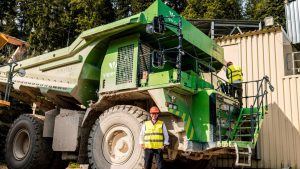Box And Body
Begin your Dump Truck Inspection walking slowly around the dump truck. Look for any cracks, rust, dents or major repairs on the truck body. Check the dump box and box liner for any signs of damage. When inspecting the dump box, note if the box is made of aluminum or steel. An aluminum box is more lightweight than a steel box and can help you reduce fuel costs over the long run. Stronger and more durable than aluminum, a steel dump box is the better choice if you will be hauling rubble or over-sized, rough heavy material.
As you continue your Dump Truck Inspection of the body and dump box, stop and take a look at the tires, noting any uneven tread wear around the entire tire circumference, a sign of a possible alignment issue.
Hydraulics
Whether the dump truck you are interested in comes with a single ram, double ram or scissor dump box lifting mechanism, step out of the cab and thoroughly inspect the lifting cylinder(s) and rod(s) for any cracks, leaks, or dents. Check the pump and reservoir tank for any signs of leaking fluid. Step back into the cab and lower the dump box, again checking for smooth operation.
In The Cab
Look at the truck’s cab and assess the overall condition of the interior. Check the odometer and make a note of the mileage. Start up the dump truck and check that all gauges, signals and lights are in working order. Note if the dump truck has a manual or automatic transmission. (If many operators with varying levels of driving experience will be using the dump truck, you may want to opt for an automatic transmission.) Begin driving the dump truck, checking for any play in the steering. Bring the dump truck to a stop and use the lifting control mechanism to raise the dump box, checking for smooth operation of the lifting cylinder(s) and rod(s).




